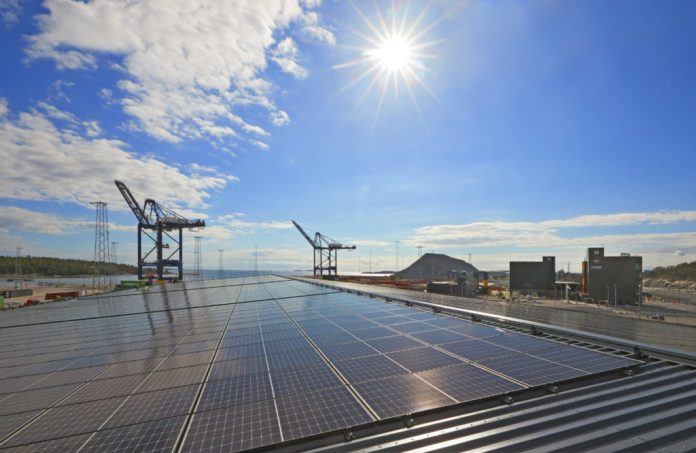The 800-MW colossus from BrightNight sets a new standard for renewables construction that benefits communities and the local environment as well as the climate.
The biggest solar installation in the eastern U.S. could soon perch atop one of the nation’s largest coal mines in southeastern Kentucky.
Developer BrightNight unveiled the unique effort at the Starfire mine last week. The surface mining operation, dating back to the 1960s, cropped rolling Appalachian mountaintops into a series of leveled plateaus; most of the area has been remediated with soil compaction and grass seeding, though mining continues in one corner of the parcel. If BrightNight’s plan succeeds, it will cover a 7,000-acre swath of this landscape with solar panels.
BrightNight plans to deliver the first phase of solar construction by 2027, filling out to 800 megawatts by 2030.
Electric truck startup Rivian signed on as the anchor customer, with a 100-megawatt power purchase agreement with BrightNight. The startup will use the power to supply the proprietary EV-charging network it’s building out. That contract is made possible because Starfire’s location within the footprint of the PJM grid network allows access to competitive markets — something that wouldn’t be available for Kentucky’s neighbors to the south.
As it stands today, the billion-dollar installation could clinch a number of superlatives in a rapidly growing industry: largest solar plant in Kentucky, largest renewable plant located on an old coal mine, maybe even largest solar project east of the Mississippi. That would be quite a feat for BrightNight, a relative newcomer to the solar development market — though the firm’s founder and CEO, Martin Hermann, previously made a name for himself building major solar and storage projects out West with 8minutenergy.
At the unveiling of the Starfire solar project, Hermann made the case for clean energy developments like this project, which can reclaim disturbed industrial landscapes and reinvigorate local economies. This strategy generates clean electricity without placing solar panels in otherwise bucolic landscapes, ideally helping to sidestep some of the growing local opposition to rural clean energy developments. It also directs decarbonization investment to communities that are feeling the economic impact of coal’s rapid decline.
“For decades, the Starfire mine was a model of American innovation and economic success,” BrightNight notes on the project webpage. ?“But this single economic driver placed residents in Knott, Perry, and Breathitt counties in jeopardy; a de-emphasis on education and lack of development in other regional businesses and industries took its toll.”
GET CAUGHT UP
black metal trusses holding solar panels are situated over a grassy canal. Several people walk on a path along the canal.
Can America’s canals double as solar farms?
Maria Gallucci
Home batteries will help bolster Puerto Rico’s grid in emergencies
Maria Gallucci
Agrivoltaics finds new fans in US Senate
Alison F. Takemura
Each of four construction phases at the Starfire solar project will create about 250 jobs, and Hermann told attendees the project will generate around $400 million in state and local tax revenue. BrightNight also pledged to invest in training and certifications to help local workers get renewable energy jobs.
BrightNight’s project design fits squarely with a new clean energy development framework crafted by the Nature Conservancy and Rivian to prioritize ?“climate, conservation, and community,” not just the cheapest possible megawatt-hours. Rivian picked the Starfire project from hundreds of proposals for corporate clean energy abiding by the framework.
Normally, clean energy companies tout new projects as powering some impressive number of homes. Rivian instead describes its Starfire contract as yielding ?“enough energy to power up to 450 million miles of renewable driving every year.” That’s not just a numbers conversion: Rivian is building its ?“Adventure Network” of public fast-charging stations, and has committed to sourcing clean electricity to match the network’s consumption.
“We’re not just optimizing for minimum dollars per megawatt-hour, we’re optimizing for maximum value creation in driving system-wide change with these projects,” Rivian Director of Renewable Energy Andrew Peterman told Canary Media. Rivian was still able to sign a ?“highly economic” power purchase agreement while pursuing these additional benefits for the energy transition, he noted.
Instead of adding clean capacity just anywhere, Starfire puts it on the third most carbon-intensive state grid (71% of Kentucky’s electricity generation in 2021 came from coal)。 As emphasized by the emerging metric of emissionality, new solar in a coal-heavy region will displace more carbon than it would in regions already flooded with solar generation in sunny hours.
Building solar in a former coal community could also unlock higher levels of tax credits from the Inflation Reduction Act, generating financial value that can be shared in the form of community investment. The project will also pay for a 20-mile transmission corridor that the developers say could support an additional gigawatt of clean energy production, taking a local swing at the U.S. transmission backlog — another major obstacle to the energy transition.
That was important for Rivian, which sees its success as a company tied to the flourishing of a decarbonized grid beyond the early strongholds of EV adoption.
“People drive Rivian vehicles all across the country,” said Peterman, who previously worked in corporate clean energy procurement for Google and Apple. ?“We can’t just focus on the easy ones, or we’ll leave behind whole parts of this country.”






